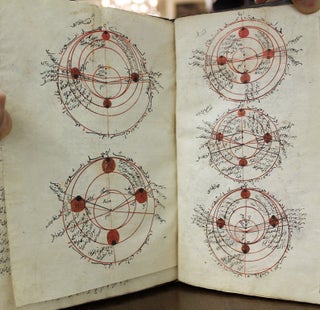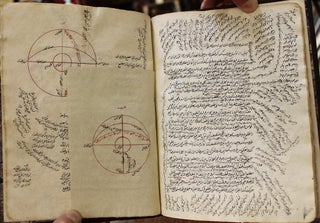Sharh al-tadhkirah (A commentary on al-Tusi's memoir)
Persia: c. 1234 A.H. (1818 A.D.). Binding: Contemporary brown full calf with tooled boards rebacked tastefully to match. Spine in five compartments of four raised bands with gilt ornamentation on all compartments. Tooled dentelles on all edges of both covers. Marbled pasted and free endpapers., Notes: Persian manuscript on paper. 31 leaves. 19 lines to the page. Based on an important work of the prominent Persian mathematician, physicist and astronomer, Al-Birjandi. Illegible writing on the verso of the first leaf with a beautiful Persian stamp and two more stamps at the end of the book presumably an ex libris.
Abd Ali ibn Muhammad ibn Husayn Birjandi (died 1528) was a prominent 16th-century Persian astronomer, mathematician and physicist who lived in Birjand, Iran. The text is written throughout in black and red ink with diagrams illustrating many of the astronomical elements discussed.
In discussing the structure of the cosmos, al-Birjandi continued Ali al-Qushji's debate on the Earth's rotation. In his analysis of what might occur if the Earth were moving, he develops a hypothesis similar to Galileo Galilei's notion of "circular inertia", which he described in the following observational test (as a response to one of Qutb al-Din al-Shirazi's arguments):
“The small or large rock will fall to the Earth along the path of a line that is perpendicular to the plane (sath) of the horizon; this is witnessed by experience (tajriba). And this perpendicular is away from the tangent point of the Earth’s sphere and the plane of the perceived (hissi) horizon. This point moves with the motion of the Earth and thus there will be no difference in place of fall of the two rocks.”
, Size: 4to (209x164mm). , Illustration: Illustrated with numerous diagrams in red ink. Written in Nasta’liq script in black ink. Significant words and phrases are written, or underlined, in red ink. Extensive commentary in margins. , Pages: P. 1-31., Category: Book Asia Middle East Iran; Book Astronomy;. The book is in very good condition. Text and diagrams are clean. Item #B5165
Binding: Contemporary brown full calf with tooled boards rebacked tastefully to match. Spine in five compartments of four raised bands with gilt ornamentation on all compartments. Tooled dentelles on all edges of both covers. Marbled pasted and free endpapers., Notes: Persian manuscript on paper. 31 leaves. 19 lines to the page. Based on an important work of the prominent Persian mathematician, physicist and astronomer, Al-Birjandi. Illegible writing on the verso of the first leaf with a beautiful Persian stamp and two more stamps at the end of the book presumably an ex libris.
Abd Ali ibn Muhammad ibn Husayn Birjandi (died 1528) was a prominent 16th-century Persian astronomer, mathematician and physicist who lived in Birjand, Iran. The text is written throughout in black and red ink with diagrams illustrating many of the astronomical elements discussed.
In discussing the structure of the cosmos, al-Birjandi continued Ali al-Qushji's debate on the Earth's rotation. In his analysis of what might occur if the Earth were moving, he develops a hypothesis similar to Galileo Galilei's notion of "circular inertia", which he described in the following observational test (as a response to one of Qutb al-Din al-Shirazi's arguments):
“The small or large rock will fall to the Earth along the path of a line that is perpendicular to the plane (sath) of the horizon; this is witnessed by experience (tajriba). And this perpendicular is away from the tangent point of the Earth’s sphere and the plane of the perceived (hissi) horizon. This point moves with the motion of the Earth and thus there will be no difference in place of fall of the two rocks.”
, Size: 4to (209x164mm). , Illustration: Illustrated with numerous diagrams in red ink. Written in Nasta’liq script in black ink. Significant words and phrases are written, or underlined, in red ink. Extensive commentary in margins. , Pages: P. 1-31., Category: Book Asia Middle East Iran; Book Astronomy;.
Price: $9,500.00




